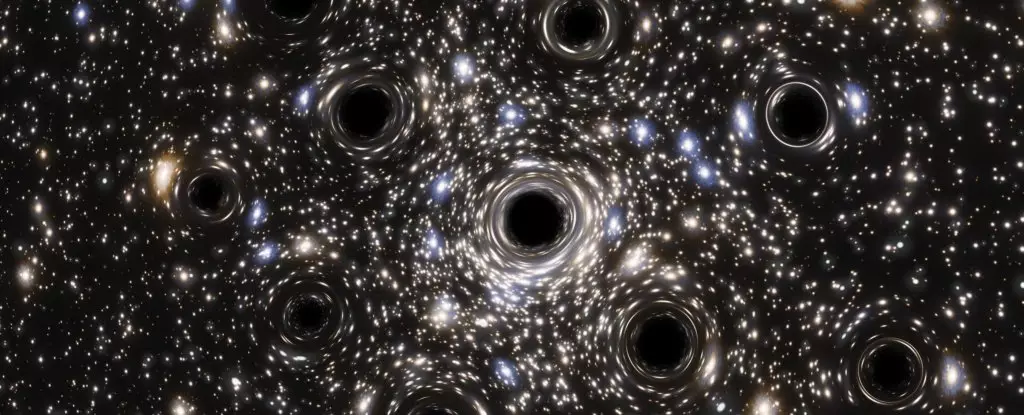Among the vast expanses of space, the marvel that is Palomar 5 serves as both a cosmic treasure trove and a puzzle to astrophysicists. Located approximately 80,000 light-years from Earth, this globular cluster, characterized by an ethereal cloud of stars extending 30,000 light-years, is hypothesized to harbor an astonishing congregation of over 100 stellar-mass black holes. Globular clusters like Palomar 5 are often regarded as relics from the genesis of the Universe, akin to celestial fossils, containing numerous ancient stars formed from similar primordial gas clouds. With roughly 150 known globular clusters spiraling through our galaxy, they remain invaluable for deciphering the chronological evolution of the cosmos and the dark matter enveloping them.
Amidst the flourishing interest in globular clusters, tidal streams have emerged as another captivating phenomenon worthy of exploration. Scientists, once limited in their identification of these lengthy ribbons of stars crisscrossing the night sky, have made remarkable advances thanks to the Gaia space observatory’s meticulous mapping of the Milky Way. These strands may offer essential clues about the gravitational forces at play in the cosmos. Astrophysicist Mark Gieles from the University of Barcelona draws attention to Palomar 5 as a potential key to unraveling the origins of these streams. Unlike other streams recently discovered—lacking an identifiable star cluster—Palomar 5 stands alone in its potential to help decipher the enigmatic relationship between cluster dynamics and tidal stream formation.
Gieles’ team explored the distinctive properties of Palomar 5 by deploying sophisticated N-body simulations to scrutinize the movements and interactions of the stars within the cluster. Employing these simulations allowed scientists to construct models of the stars’ orbits and discern the processes governing their present formations. Notably, recent theoretical frameworks suggest that stellar black holes might reside within the cores of globular clusters, resulting in significant gravitational interactions that could disrupt the cluster’s structure.
The simulations factored in these black holes, leading to compelling results: a population of stellar-mass black holes characterized the heart of Palomar 5, significantly influencing its current arrangement. Remarkably, the findings indicated a greater-than-anticipated number of black holes—over three times the expected representation based on the cluster’s total star count. This revelation poses unprecedented implications, suggesting that more than 20% of Palomar 5’s mass may be constituted by these elusive black holes.
The Fate of Palomar 5: Erosion and Transformation
The implications of these simulations extend beyond the current mass distribution within Palomar 5; they also paint a striking picture of the cluster’s inevitable decline. Over the course of roughly one billion years, studies indicate that the cluster will disintegrate entirely into an elongated tidal stream. This transformation hints at a cosmic cycle where even robust clusters such as Palomar 5 ultimately yield themselves to the overarching gravitational embrace of the Milky Way—dissolving into a scattering of black holes and stars.
As Gieles elaborated, this dissolutive process may not be singular to Palomar 5; rather, it raises questions about the ultimate destinies of other globular clusters. The shared fate posits that many such clusters are on a trajectory toward similar dissolution, eventually relinquishing their identities as compact groupings of stars.
Implications for the Search of Black Holes
Furthermore, the findings from Palomar 5 herald vital insights into the framework for studying black holes within the cosmos. The notion that globular clusters may be fertile grounds for locating black holes hints at exciting avenues for future research. The emergence of multiple black hole mergers, facilitated by dense stellar environments typical of clustered formations, poses the prospect of unveiling new classes of black holes—particularly those categorized as middleweight, nestled between stellar and supermassive black holes.
What remains central to the exploration of black holes in such settings is the underlying paradox: while theoretical models suggest profound insights into their existence, observational constraints often hinder efforts to directly visualize these objects. This challenge complicates our understanding, as astrophysicists like Fabio Antonini from Cardiff University note the uncertainty shrouding the actual population of black holes within clusters, emphasizing the need for continued investigative rigor.
Concluding Thoughts on the Journey of Knowledge
The investigation into the contrasting identities of Palomar 5 provides a crucial appreciation of the dynamic and evolving nature of cosmic structures. As researchers continue to delve deeper into the myriad worlds hidden within globular clusters, they unlock layers of understanding that stretch to the very fabric of our universe. The journey through stellar evolution and black hole dynamics signals a vibrant frontier in astrophysics, one where the quest for knowledge is intertwined with the mysteries of existence itself.


Leave a Reply